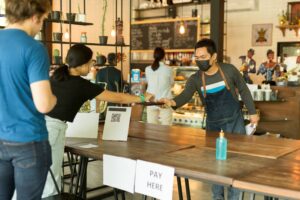Consumption habits have been deeply disrupted by the emergence of COVID-19, leaving shoppers and retailers with much uncertainty about the path ahead. Research from KPMG suggests almost half of consumers have had their income negatively impacted by the global crisis, and won’t resume old levels of activity until a vaccine becomes available. Most consumers expect economic recovery within two years, but some believe we may never return to business-as-usual before the coronavirus crisis.
However, that same research indicates that new archetypes have emerged. Nearly half of shoppers (45%) fall under the category of “Proceed with Caution”—a wary group that has not been impacted by job loss or reduced spending as of yet. Another 27% are categorized in the “Hunker Down and Save” group—they are a relatively affluent bunch, but concerned about the economy, so they spend less on discretionary items and save more.
Those who were in a dire financial position before the pandemic and have been heavily impacted by job loss and income reduction represent 23% of shoppers. Another 5% of high-spending shoppers are “Ready To Roll”—a young group in denial about the deleterious effects of the virus on the economy.
Though it may be tempting to view shifts in consumer shopping patterns as temporary and transitional, we can expect many changes in consumer behavior post-COVID-19 to persist.
Consumer Behavior: Fear of the Unknown
Less than half a year ago, most shoppers never paused before touching a can of soup, wondering if a deadly, unseen pathogen was lurking on its surface. They didn’t hesitate to feel the exquisite softness of a cashmere sweater or gather in close-knit hordes for a Black Friday deal.
Now, customers have grown accustomed to a palpable fear associated with places of mass gatherings like brick-and-mortar stores. Most will likely be looking for visible signs that your business prioritizes safety and sanitizes the shop thoroughly in accordance to CDC guidelines.
What You Can Do:
- Communicate any changes your business has made in response to COVID-19.
- Put up signage showing when, how, and by whom the store has been sanitized.
- Have staff visibly cleaning the store during high-traffic hours to demonstrate care.
- Restrict the number of people who are allowed in the store at any given time.
- Offer early hours for senior citizens, the immuno-compromised, and other at-risk groups.
- Have employees wear personal protective equipment (PPE), providing applicability.
- Install buffers between employees and customers as an additional sanitation measure.
- Place hand sanitizer stations around the store and invest in top-quality HVAC.
- Switch to touchless, cashless payment systems—the preference of two-thirds of shoppers.
- Utilize outdoor spaces to carry out business (including small pop-up shops), providing feasibility.
- Boost consumer convenience via virtual ordering and physical pickup lockers.
- Consider granting access to your establishment based on temperature checks and authorization.
Consumer Behavior: Fluctuating Shopping Frequency and Bulk Purchases
Grocery sales have been the most heavily-impacted. Before COVID-19, household food shopping trips occurred about three times per week, with shoppers frequenting a variety of retail channels for their needs. In the early weeks of the outbreak, grocery trips jumped to about four visits per week as shoppers “stocked up” for the lockdown, though 40% of shoppers said they visited fewer stores. Spending per trip increased 33%.
From February to March, food retail revenue surged 25% overall, driving an astounding eight years’ worth of normal growth in a matter of weeks. Shoppers filled their pandemic pantries with record amounts of toilet paper, hand sanitizer, canned soup, rice, pasta, meats, and milk. As the pandemic wears on, there are greater discrepancies in trip frequency; in some places, shoppers are making more trips in fear of another round of shelter-in-place orders, whereas shoppers in calmer zones are making fewer trips as they wait out the virus.
What You Can Do:
- Re-evaluate your supply chain partners for reliability and ensure there are no weak links.
- Shift the focus from offering a wide variety of products to ensuring shelves are stocked.
- Leverage real-time inventory management tools to assess immediate and future needs.
- Skip supplier warehousing and ship directly to store warehouses to expedite deliveries.
- Supply key goods in larger bulk packaging sizes to accommodate stockups.
- Increase the number of value-conscious options for consumers hit hard by the downturn.
- Limit purchases of items that are in high demand and difficult to re-stock.
- Seek alternative products to fill the gaps when popular brands run out.
Consumer Behavior: Shopping Mindful and Local
During the early phases of the pandemic, purchase patterns were severely disrupted. Consumers who were furloughed or ordered to stay home during the lockdown no longer stopped at their usual commute-route stores; instead, they looked for hyper-local locations closest to their homes. As a result, smaller stores began to gain market share.
Shoppers feared the impact coronavirus may have on their immediate communities, so they increasingly displayed a preference for brands that supported mask-making efforts, sourced their raw materials ethically, and communicated a focus on health. Also, due to the current economic climate, many shoppers are looking for quality goods at an affordable price.
What You Can Do:
- Appeal to bargain hunters without discounting using a reward point program.
- Advertise raw material sourcing and commitment to quality.
- Donate to a charitable organization or look for other ways to support public health.
- Attract nearby shoppers with local keyword phrases in your PPC marketing and content marketing.
- Educate consumers about waste and what they can do to support the local economy.
- Interact with local charities and seek out cross-promotional opportunities for scaled PR.
Consumer Behavior: Omni-channel Buying
Whether it’s groceries, clothing, cleaning products, or other goods, the majority of Americans have had to adapt to and learn online shopping. Consumers still love the thrill of perusing items in-person, but the convenience of eCommerce home delivery and “Buy Online, Pickup In Store” (BOPIS) options have driven the proliferation of omni-channel shopping that occurs across desktops, mobile devices, and physical locations.
A 160% increase in eCommerce purchases from new or low-frequency users is anticipated as a result of the COVID-19 crisis. Shopping app engagement surged by 40% from March 2019 to March 2020.
What You Can Do:
 Ensure that your website is fully optimized to provide a satisfactory user experience, especially on mobile devices.
Ensure that your website is fully optimized to provide a satisfactory user experience, especially on mobile devices.- Create high-functioning, info-rich landing pages geared toward eCommerce conversion.
- Alleviate obstacles to purchase by streamlining the checkout process.
- Scale up delivery with in-house capabilities or new partnerships to fulfill demand.
- Invest in virtual in-store demonstrations and live chat personnel.
- Launch virtual try-on technology or hassle-free returns to help with sizing.
- Cross-train store personnel to assist with eCommerce orders.
- Share experiential content through live-streaming channels.
- Target shoppers over age 50 with easy subscription and ordering models.
- Offer BOPIS, which has increased 208% from April 1-20, 2020.
- Assist customers remotely via virtual consultations led by brand ambassadors.
- Provide a shopping app that delivers high value, such as personalized offers and rewards.
- Reallocate offline spending to digital channels like paid search and social shopping.
- Seek partnerships with popular mobile shopping apps to reach new audiences.
Will You Be Ready to Adapt to Changes in Consumer Behavior Post-COVID-19?
It can be difficult to predict what comes next, given the dynamic nature of public health crises. However, you can strategically align yourself with innovators who quickly adapt to these changes and create strong, forward-thinking shopping trends. Shopkick is one such innovator.
Customers download Shopkick’s mobile shopping app to receive reward points from a multitude of retail and CPG partners that they can use toward gift cards of their choosing. Consumers earn points through sustained engagement with partnering brands, such as watching branded videos, purchasing certain products, flipping through curated lookbooks, or locating and scanning items in-store.
Partners can expect a high ROI on Shopkick’s multifaceted campaigns that can drive trial and consideration, boost incremental purchases, and foster powerful brand loyalty and affinity that persists long after the coronavirus vaccine arrives.
To learn how Shopkick is preparing partnering brands to adapt to changes in consumer behavior post-COVID-19, read our success stories and then contact Shopkick so you too can emerge from the pandemic as a brand shoppers trust and remember.
Image courtesy of Bignai





